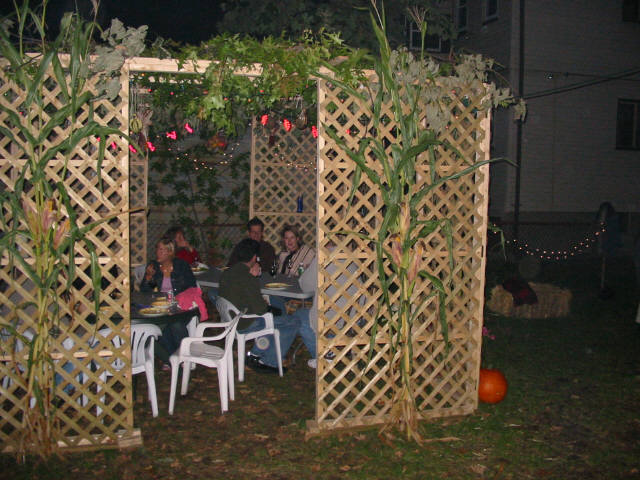This festival is sometimes referred to as Zeman Simkhateinu, the Season of our Rejoicing. Sukkot lasts for seven days. The two days following the festival are separate holidays, Shemini Atzeret and Simkhat Torah, but are commonly thought of as part of Sukkot.
The word "Sukkot" means "booths," and refers to the temporary dwellings that we are commanded to live in during this holiday. The name of the holiday is frequently translated "The Feast of Tabernacles," which, like many translations of technical Jewish terms, isn't terribly useful unless you already know what the term is referring to. The Hebrew pronunciation of Sukkot is "Sue COAT," but is often pronounced as in Yiddish, to rhyme with "BOOK us."
Like Passover and Shavu'ot, Sukkot has a dual significance: historical and agricultural. The holiday commemorates the forty-year period during which the children of Israel were wandering in the desert, living in temporary shelters. Sukkot is also a harvest festival, and is sometimes referred to as Chag Ha-Asif, the Festival of Ingathering.
The festival of Sukkot is instituted in Leviticus 23:33 et seq. No work is permitted on the first and second days of the holiday. Work is permitted on the remaining days. These intermediate days on which work is permitted are referred to as Chol Ha-Mo'ed, as are the intermediate days of Passover.
In honor of the holiday's historical significance, we are commanded to dwell in temporary shelters, as our ancestors did in the wilderness. The commandment to "dwell" in a sukkah can be fulfilled by simply eating all of one's meals there; however, if the weather, climate, and one's health permit, one should live in the sukkah as much as possible, including sleeping in it.
A sukkah must have at least three walls covered with a material that will not blow away in the wind. Canvas covering tied or nailed down is acceptable and quite common in the United States. A sukkah may be any size, so long as it is large enough for you to fulfill the commandment of dwelling in it. The roof of the sukkah must be made of material referred to as sekhakh (literally, covering). To fulfill the commandment, sekhakh must be something that grew from the ground and was cut off, such as tree branches, corn stalks, bamboo reeds, sticks, or two-by-fours. Sekhakh must be left loose, not tied together or tied down. Sekhakh must be placed sparsely enough that rain can get in, and preferably sparsely enough that the stars can be seen, but not so sparsely that more than ten inches is open at any point or that there is more light than shade. The sekhakh must be put on last.
It is common practice, and highly commendable, to decorate the sukkah. In the northeastern United States, Jews commonly hang dried squash and corn in the sukkah to decorate it, because these vegetables are readily available at that time for the American holidays of Halloween and Thanksgiving. Building and decorating a sukkah is a fun, family project, much like decorating the Christmas tree is for Christians. It is a sad commentary on modern American Judaism that most of the highly assimilated Jews who complain about being deprived of the fun of having and decorating a Christmas tree have never even heard of Sukkot.
The following blessing is recited when eating a meal in the sukkah:
"Baruch atah adonai eloheinu melech ha'olam asher
kid'shanu b'mitzvotav v'tzivanu leisheiv basukkah".
Many Americans, upon seeing a decorated sukkah for the first time, remark on how much the sukkah (and the holiday generally) reminds them of Thanksgiving. This is not entirely coincidental. Our American pilgrims, who originated the Thanksgiving holiday, were deeply religious people. When they were trying to find a way to express their thanks for their survival and for the harvest, they looked to the Bible for an appropriate way of celebrating and based their holiday in part on Sukkot. (Nifty facts they don't teach you in public school!)
Another observance related to Sukkot involves what are known as The Four Species (arba minim in Hebrew) or the lulav and etrog. We are commanded to take these four plants and use them to "rejoice before the L-rd." The four species in question are an etrog (a citrus fruit native to Israel), a palm branch (in Hebrew, lulav), a myrtle branch (hadas) and a willow branch (arava).
Every morning of Sukkot, except on Shabbat, it is the custom to hold the lulav in the right hand and the etrog in the left. Bringing them together (with the pitam, the stem of the etrog pointing downward), the following blessing is recited:
"Baruch atah adonai eloheinu melech ha'olam asher
kid'shanu b'mitzvotav v'tzivanu al n'tilat lulav".
The four species are also held during the Hallel prayer in religious services, and are held during processions around the bimah (the pedestal where the Torah is read) each day during the holiday. These processions commemorate similar processions around the alter of the ancient Temple in Jerusalem. The processions are known as Hoshanahs, because while the procession is made, we recite a prayer with the refrain, "Hosha na!" (please save us!). On the seventh day of Sukkot, seven circuits are made. For this reason, the seventh day of Sukkot is known as Hoshanah Rabbah (the great Hoshanah).

By: Jewish Virtual Library







No comments:
Post a Comment